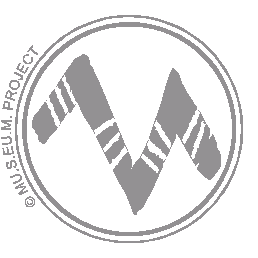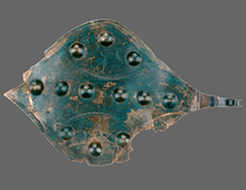|
||||||||||||||||||||||||||||||||
|
|
Museum of: Berlin | |||||||||||||||||||||||||||||||
| Name of the artefact: Belt plate | ||||||||||||||||||||||||||||||||
|
The thin belt plate in shape of a rhombus is damaged on
one edge. At the other side there is an eyelet, which was used for close
the belt. |
||||||||||||||||||||||||||||||||
|
WHERE IS IT AND MAIN
CHARACTERISTICS |
STATE |
|||||||||||||||||||||||||||||||
|
Department: |
Museum for Pre- and Early
History |
Preservation: |
Very good | |||||||||||||||||||||||||||||
|
Inventory number: |
II 10765 |
Restauration: |
Restored | |||||||||||||||||||||||||||||
|
Name of the artefact: |
Belt plate |
Completeness: |
Complete | |||||||||||||||||||||||||||||
|
Object type: |
Other |
|||||||||||||||||||||||||||||||
|
Material: |
Bronze |
|||||||||||||||||||||||||||||||
|
Methof of manufacture: |
Bronze casting |
|||||||||||||||||||||||||||||||
|
Decoration
type: |
Incision |
|||||||||||||||||||||||||||||||
|
Distinctive mark: |
Depiction of ships and birds |
|||||||||||||||||||||||||||||||
|
DIMENSIONS |
PERIOD OF USE |
|||||||||||||||||||||||||||||||
|
Length (mm): |
227 |
Epoque: |
Bronze Age |
|||||||||||||||||||||||||||||
|
Heigth
(mm): |
- |
Culture: |
- |
|||||||||||||||||||||||||||||
|
Diameter
(mm): |
- |
Period: |
Late Bronze Age |
|||||||||||||||||||||||||||||
|
Width (mm): |
140 |
Face: |
- |
|||||||||||||||||||||||||||||
|
Thickness (mm): |
0.5 |
Absolute chronology: |
9 - 8 century BC |
|||||||||||||||||||||||||||||
|
Weight
(g): |
60 |
|||||||||||||||||||||||||||||||
DISCOVERY |
||||||||||||||||||||||||||||||||
|
Date: |
1875 |
Country: |
Poland |
|||||||||||||||||||||||||||||
|
District: |
Woj. Pila |
Town hall affiliation: |
Trzcianka |
|||||||||||||||||||||||||||||
|
Village: |
Radolinek (Floth) |
Discovery findspot: |
Bank of the river Netze |
|||||||||||||||||||||||||||||
|
Condition of discovery: |
Chance Discovery |
Discovery type: |
Deposit |
|||||||||||||||||||||||||||||
|
ANALYSES – DETERMINATIONS |
FILLED IN BY |
|||||||||||||||||||||||||||||||
|
Type: |
- |
Name: |
Dr. Manfred Nawroth |
|||||||||||||||||||||||||||||
|
Laboratory: |
- |
Institution: |
Museum for Pre- and early
History |
|||||||||||||||||||||||||||||
|
No./Code: |
- |
Date: |
11/11/2005 |
|||||||||||||||||||||||||||||
|
DEEPENINGS |
||||||||||||||||||||||||||||||||
|
Morphology of the object: |
||||||||||||||||||||||||||||||||
|
The thin belt plate in shape of a rhombus is damaged on
one edge. At the other side there is an eyelet, which was used for close
the belt. |
||||||||||||||||||||||||||||||||
|
Decoration: |
||||||||||||||||||||||||||||||||
|
The plate is decorated with incised lines and
point-fringed hemispheres. |
||||||||||||||||||||||||||||||||
|
Inscription: |
||||||||||||||||||||||||||||||||
|
- |
||||||||||||||||||||||||||||||||
|
Analogies: |
||||||||||||||||||||||||||||||||
|
The illustration of birds, ships and the sun is well
known from Scandinavian and northern German Bronze Age objects like razor
blades, sun discs or the famous the solar wagon from Trundholm in Denmark.
|
||||||||||||||||||||||||||||||||
|
Interpretation: |
||||||||||||||||||||||||||||||||
|
The plate is decorated with incised lines and
point-fringed hemispheres as symbols of the wandering sun. Some of the
suns were moved by stylized birds. Along the horizontal main axis are two
bended figures with narrowing ends forming animal heads (probably of
birds) and are called ships with bird protomes. In the middle of each ship
stands a human figure whose head is marked by a double circle. The linear
body with a fish-boned chest continues in legs formed as bundles of lines.
The arms are raised in a praying position. Circling the figure a sun
pulled by a bird moves from sunrise past the zenith to sunset. The
marginal illustration shows a ship pulled by birds. The ship is moving
forward to a human figure. The body line of the human leads to a sun ball
which forms the head. During the Bronze Age the sun was most likely
personified and illustrated as a human and plays a central role in the
religious belief. |
||||||||||||||||||||||||||||||||
|
Bibliography: |
||||||||||||||||||||||||||||||||
|
- |
||||||||||||||||||||||||||||||||

